Estimation, Classification, and Prediction of Construction and Demolition Waste Using Machine Learning for Sustainable Waste Management: A Critical Review
Abstract
1. Introduction
2. Review Methodology
2.1. Systematic Review Study Selection
2.2. Annual Distribution of Publications
2.3. Publication Type
2.4. Source Analysis
2.5. Publication Distribution by Countries
2.6. Co-Occurrence Analysis of Keywords
3. Traditional Method of Estimation, Classification, and Prediction of CDW
3.1. Estimation
3.2. Classification
3.3. Prediction
3.4. Results and Discussions
4. Review of Machine Learning Applications for Estimating C&D Waste
4.1. Regression Models
4.2. Deep Learning Techniques for Estimation
4.3. Hybrid Approaches
5. Review of Machine Learning Applications’ Classification of C&D Waste
5.1. Image Processing and Computer Vision Techniques
5.2. Feature Extraction and Classification Algorithms
5.3. Deep Learning Techniques
6. Review of Machine Learning Applications’ Prediction of C&D Waste
6.1. Time Series Analysis and Forecasting Models
- A.
- ARIMA (Auto Regressive Integrated Moving Average) is a time series-forecasting technique that combines autoregressive, integrated, and moving average components [46]. It is used to analyze historical waste generation data and predict future quantities, offering interpretable results for univariate series with clear patterns. However, it assumes linear relationships and requires stationary data, often needing preprocessing like differencing [50].
- B.
- A LSTM (Long Short-Term Memory) Network is a type of recurrent neural network designed to learn from sequential data and capture long-term dependencies. It is particularly useful for modeling complex patterns in construction and demolition (C&D) waste generation, considering factors like project type, location, and economic conditions [51]. LSTM can handle nonlinear relationships and multiple input features, improving prediction accuracy with large datasets. However, it requires more computational resources and tuning, and its complexity can make it less interpretable than simpler models [52].
6.2. Regression Models (Linear, Nonlinear, Ensemble)
6.2.1. Linear Regression
6.2.2. Nonlinear Regression
6.2.3. Ensemble Models
6.3. Hybrid Approaches for Predicting C&D Waste Generation
6.3.1. Combining Statistical Models with Machine Learning
6.3.2. Ensemble Learning with Traditional Methods
6.3.3. Machine Learning Post-Processing of Traditional Models
6.3.4. Feature Engineering Using Domain Knowledge
6.4. Statistical Comparison of Predictive Machine Learning Models
7. Comparative Analysis of Machine Learning, AI, Economic Modeling, and Smart Technologies in C&D Waste Management
8. Limitations, Practical Implications, and Future Research Directions
9. Conclusions
- Introduction to C&D Waste Management Challenges: Effective management of construction and demolition (C&D) waste poses significant environmental, economic, and operational challenges. Traditional methods, including manual surveys, visual inspections, statistical analyses, and Building Information Modeling (BIM), provide insights but lack the precision and scalability needed for modern systems.
- Emergence of Machine Learning in Waste Management: Machine learning (ML) techniques have revolutionized waste management, offering advanced predictive modeling capabilities. Models like Random Forest (RF), Gradient Boosting Machines (GBMs), artificial neural networks (ANNs), and convolutional neural networks (CNNs) consistently outperform traditional methods in accuracy and reliability.
- Predictive Accuracy of ML Models: ML models achieve R2 values often exceeding 0.9, demonstrating robust predictive capabilities that are essential for strategic decision-making in waste management. Hybrid approaches, such as combining Categorical Principal Component Analysis (CATPCA) with support vector machine regression (SVMR), further enhance predictive performance, particularly in demolition waste generation and material recovery.
- Integration of Large and Unstructured Data: Advanced ML frameworks excel in handling large datasets and real-time inputs, including unstructured data like images, which is crucial for material classification tasks. These frameworks optimize waste estimation, recovery, and cost-effective data-driven strategies that are aligned with sustainability goals.
- Challenges in ML-Driven Waste Management: Despite the advantages, challenges such as data heterogeneity, computational demands, and integration barriers remain. Overcoming these obstacles requires standardized data collection protocols, enhanced computational tools, and cross-sector collaboration among stakeholders.
- The Role of ML in Promoting Sustainable Practices: This analysis underscores the transformative potential of ML in C&D waste management. By providing precise, scalable, and adaptable solutions, ML-driven methodologies support the transition to a circular economy, promote sustainable construction practices, and aid evidence-based policy development.
Author Contributions
Funding
Conflicts of Interest
References
- Dantas, A.T.A.; Batista Leite, M.; De Jesus Nagahama, K. Prediction of compressive strength of concrete containing construction and demolition waste using artificial neural networks. Constr. Build. Mater. 2013, 38, 717–722. [Google Scholar] [CrossRef]
- Coskuner, G.; Jassim, M.S.; Zontul, M.; Karateke, S. Application of artificial intelligence neural network modeling to predict the generation of domestic, commercial and construction wastes. Waste Manag. Res. 2021, 39, 499–507. [Google Scholar] [CrossRef] [PubMed]
- Chen, J.; Lu, W.; Yuan, L.; Wu, Y.; Xue, F. Estimating construction waste truck payload volume using monocular vision. Resour. Conserv. Recycl. 2022, 177, 106013. [Google Scholar] [CrossRef]
- Ministry of Environment, Forest and Climate Change. Construction and Demolition Waste Management Rules; Ministry of Environment, Forest and Climate Change: New Delhi, India, 2016. [Google Scholar]
- Demetriou, D.; Mavromatidis, P.; Robert, P.M.; Papadopoulos, H.; Petrou, M.F.; Nicolaides, D. Real-time construction demolition waste detection using state-of-the-art deep learning methods; single-stage vs two-stage detectors. Waste Manag. 2023, 167, 194–203. [Google Scholar] [CrossRef] [PubMed]
- Shooshtarian, S.; Caldera, S.; Maqsood, T.; Ryley, T. Using recycled construction and demolition waste products: A review of stakeholders’ perceptions, decisions, and motivations. Recycling 2020, 5, 31. [Google Scholar] [CrossRef]
- Ginga, C.P.; Ongpeng, J.M.C.; Daly, M.K.M. Circular Economy on Construction and Demolition Waste: A Literature Review on Material Recovery and Production. Materials 2020, 13, 2970. [Google Scholar] [CrossRef] [PubMed]
- Vergara, S.E.; Tchobanoglous, G. Municipal solid waste and the environment: A global perspective. Annu. Rev. Environ. Resour. 2012, 37, 277–309. [Google Scholar] [CrossRef]
- Kumar, A.; Dasgupta, H. Perception Study on IOT Based Waste Management System. J. Phys. Conf. Ser. 2021, 1964, 062110. [Google Scholar] [CrossRef]
- Kaza, S.; Yao, L.; Bhada-Tata, P.; Van Woerden, F. What a Waste 2.0: A Global Snapshot of Solid Waste Management to 2050; World Bank Publications: Washington, DC, USA, 2018. [Google Scholar]
- Pathak, A.; Kumar, S.; Jha, V.K. Development of building material from geopolymerization of construction and demolition waste (CDW). Trans. Indian Ceram. Soc. 2014, 73, 133–137. [Google Scholar] [CrossRef]
- Chen, X.-F.; Quan, C.-Q.; Jiao, C.-J. Experimental Study of Chloride Resistance of Polypropylene Fiber Reinforced Concrete with Fly Ash and Modeling. Materials 2021, 14, 4417. [Google Scholar] [CrossRef]
- Gulghane, A.; Sharma, R.L.; Borkar, P. A formal evaluation of KNN and decision tree algorithms for waste generation prediction in residential projects: A comparative approach. Asian J. Civ. Eng. 2024, 25, 265–280. [Google Scholar] [CrossRef]
- Ameh, O.J.; Danielm, E.I. Professionals’ views of material wastage on construction sites and cost overruns. Organ. Technol. Manag. Constr. Int. J. 2013, 5, 747–757. [Google Scholar]
- Cha, G.-W.; Moon, H.J.; Kim, Y.-C. A hybrid machine-learning model for predicting the waste generation rate of building demolition projects. J. Clean. Prod. 2022, 375, 134096. [Google Scholar] [CrossRef]
- Akanbi, L.A.; Oyedele, A.O.; Oyedele, L.O.; Salami, R.O. Deep learning model for Demolition Waste Prediction in a circular economy. J. Clean. Prod. 2020, 274, 122843. [Google Scholar] [CrossRef]
- Nagalli, A. Estimation of construction waste generation using machine learning. In Proceedings of Institution of Civil Engineers: Waste and Resource Management; Thomas Telford Ltd.: London, UK, 2021; Volume 174. [Google Scholar]
- Chrysanidis, T.; Mousama, D.; Tzatzo, E.; Alamanis, N.; Zachos, D. Study of the effect of a seismic zone to the construction cost of a five-story reinforced concrete building. Sustainability 2022, 14, 10076. [Google Scholar] [CrossRef]
- Lu, W.; Lou, J.; Webster, C.; Xue, F.; Bao, Z.; Chi, B. Estimating construction waste generation in the Greater Bay Area, China using machine learning. Waste Manag. 2021, 134, 78–88. [Google Scholar] [CrossRef] [PubMed]
- Iyiola, C.O.; Shakantu, W.; Daniel, E.I. Digital Technologies for Promoting Construction and Demolition Waste Management: A Systematic Review. Buildings 2024, 14, 3234. [Google Scholar] [CrossRef]
- Soultanidis, V.; Voudrias, E.A. Modelling of demolition waste generation: Application to Greek residential buildings. Waste Manag. Res. 2023, 41, 1469–1479. [Google Scholar] [CrossRef] [PubMed]
- Gao, Y.; Wang, J.; Xu, X. Machine learning in construction and demolition waste management: Progress, challenges, and future directions. Autom. Constr. 2024, 162, 105380. [Google Scholar] [CrossRef]
- Sung, W.-T.; Hsu, C.-C. IOT system environmental monitoring using IPSO weight factor estimation. Sens. Rev. 2013, 33, 246–256. [Google Scholar] [CrossRef]
- Wu, P.-Y.; Sandels, C.; Mjörnell, K.; Mangold, M.; Johansson, T. Predicting the presence of hazardous materials in buildings using machine learning. Build. Environ. 2022, 213, 108894. [Google Scholar] [CrossRef]
- Cha, G.-W.; Park, C.-W.; Kim, Y.-C. Optimal Machine Learning Model to Predict Demolition Waste Generation for a Circular Economy. Sustainability 2024, 16, 7064. [Google Scholar] [CrossRef]
- Rahman, M.W.; Islam, R.; Hasan, A.; Bithi, N.I.; Hasan, M.M.; Rahman, M.M. Intelligent waste management system using deep learning with IoT. J. King Saud Univ.-Comput. Inf. Sci. 2022, 34, 2072–2087. [Google Scholar] [CrossRef]
- Kang, K.; Besklubova, S.; Dai, Y.; Zhong, R.Y. Building demolition waste management through smart BIM: A case study in Hong Kong. Waste Manag. 2022, 143, 69–83. [Google Scholar] [CrossRef] [PubMed]
- Mercader-Moyano, P.; López-López, J.; Camporeale, P.E. An environmental construction and demolition waste management model to trigger post-pandemic economic recovery towards a circular economy: The Mexican and Spanish cases. In Environmental Footprints of Recycled Products; Springer Nature: Singapore, 2022; pp. 83–135. [Google Scholar]
- Wang, J.; Wei, J.; Liu, Z.; Huang, C.; Du, X. Life cycle assessment of building demolition waste based on building information modeling. Resour. Conserv. Recycl. 2022, 178, 106095. [Google Scholar] [CrossRef]
- Bui, T.D.; Tsai, F.M.; Tseng, M.L.; Ali, M.H. Identifying sustainable solid waste management barriers in practice using the fuzzy Delphi method. Resour. Conserv. Recycl. 2020, 154, 104625. [Google Scholar] [CrossRef]
- Teixeira, E.D.C.; González, M.A.S.; Heineck, L.F.M.; Kern, A.P.; Bueno, G.M. Modelling waste generated during construction of buildings using regression analysis. Waste Manag. Res. 2020, 38, 857–867. [Google Scholar] [CrossRef]
- Gulghane, A.; Sharma, R.L.; Borkar, P. Quantification analysis and prediction model for residential building construction waste using machine learning technique. Asian J. Civ. Eng. 2023, 24, 1459–1473. [Google Scholar] [CrossRef]
- Cha, G.-W.; Choi, S.-H.; Hong, W.-H.; Park, C.-W. Developing a Prediction Model of Demolition-Waste Generation-Rate via Principal Component Analysis. Int. J. Environ. Res. Public Health 2023, 20, 3159. [Google Scholar] [CrossRef]
- Cha, G.-W.; Choi, S.-H.; Hong, W.-H.; Park, C.-W. Development of Machine Learning Model for Prediction of Demolition Waste Generation Rate of Buildings in Redevelopment Areas. Int. J. Environ. Res. Public Health 2023, 20, 107. [Google Scholar]
- Cha, G.-W.; Hong, W.-H.; Choi, S.-H.; Kim, Y.-C. Developing an Optimal Ensemble Model to Estimate Building Demolition Waste Generation Rate. Sustainability 2023, 15, 10163. [Google Scholar] [CrossRef]
- Cha, G.-W.; Hong, W.-H.; Kim, Y.-C. Performance Improvement of Machine Learning Model Using Autoencoder to Predict Demolition Waste Generation Rate. Sustainability 2023, 15, 3691. [Google Scholar] [CrossRef]
- Haleem, A.; Javaid, M.; Khan, I.H.; Mohan, S. Significant Applications of Artificial Intelligence Towards Attaining Sustainability. J. Ind. Integr. Manag. 2023, 8, 489. [Google Scholar] [CrossRef]
- Rema, R.; Nalanth, N. Deep Learning-Based Swot Analysis in Construction and Demolition Waste Management. Intell. Autom. Soft Comput. 2023, 36, 1497–1506. [Google Scholar] [CrossRef]
- Lu, W.; Long, W.; Yuan, L. A machine learning regression approach for pre-renovation construction waste auditing. J. Clean. Prod. 2023, 397, 136596. [Google Scholar] [CrossRef]
- Cha, G.; Moon, H.; Kim, J. A method to improve the performance of support vector machine regression model for predicting demolition waste generation using categorical principal components analysis. Int. J. Sustain. Build. Technol. Urban Dev. 2021, 12, 282–294. [Google Scholar]
- Cha, G.W.; Moon, H.-J.; Kim, Y.-C. Comparison of random forest and gradient boosting machine models for predicting demolition waste based on small datasets and categorical variables. Int. J. Environ. Res. Public Health 2021, 18, 8530. [Google Scholar] [CrossRef] [PubMed]
- Mučenski, V.; Trivunić, M.; Ćirović, G.; Peško, I.; Dražić, J. Estimation of recycling capacity of multi-storey building structures using artificial neural networks. Acta Polytech. Hung. 2013, 10, 175–192. [Google Scholar]
- Awad, R.; Budayan, C.; Gurgun, A.P. Construction and Demolition Waste Generation Prediction by Using Artificial Neural Networks and Metaheuristic Algorithms. Buildings 2024, 14, 3695. [Google Scholar] [CrossRef]
- Kern, A.P.; Dias, M.F.; Kulakowski, M.P.; Gomes, L.P. Waste generated in high-rise buildings construction: A quantification model based on statistical multiple regression. Waste Manag. 2015, 39, 35–44. [Google Scholar] [CrossRef] [PubMed]
- Lv, S.; Liu, X.; Cao, Y. Remote sensing image recognition of dust cover net construction waste: A method combining convolutional block attention module and U-Net. Sens. Mater. 2024, 36, 3131–3145. [Google Scholar] [CrossRef]
- Fang, Y.; Shi, X.; Chen, Y.; He, J. Quantity Prediction of Construction and Demolition Waste Using Weighted Combined Grey Theory and Autoregressive Integrated Moving Average Model. Sustainability 2024, 16, 5255. [Google Scholar] [CrossRef]
- Davis, P.; Aziz, F.; Newaz, M.T.; Sher, W.; Simon, L. The classification of construction waste material using a deep convolutional neural network. Autom. Constr. 2021, 122, 103481. [Google Scholar] [CrossRef]
- Kapadia, H.; Patel, A.; Patel, J.; Patidar, S.; Richhriya, Y.; Trivedi, D.; Patel, P.; Mehta, M. Dry waste segregation using seamless integration of deep learning and industrial machine vision. In Proceedings of the CONECCT 2021: 7th IEEE International Conference on Electronics, Computing and Communication Technologies, Bangalore, India, 9–11 July 2021. [Google Scholar]
- Nežerka, V.; Zbíral, T.; Trejbal, J. Machine-learning-assisted classification of construction and demolition waste fragments using computer vision: Convolution versus extraction of selected features [Formula presented]. Expert Syst. Appl. 2024, 238, 121568. [Google Scholar] [CrossRef]
- Yang, H.; Liu, Y.; Jia, J.; Liu, X. Construction Waste Production Prediction and Correlation Analysis Based on ARIMA-BP Combination Model. In International Conference on Environmental Pollution and Governance; Springer International Publishing: Cham, Switzerland, 2022; pp. 97–106. [Google Scholar]
- Huang, L.; Cai, T.; Zhu, Y.; Zhu, Y.; Wang, W.; Sun, K. LSTM-based forecasting for urban construction waste generation. Sustainability 2020, 12, 8555. [Google Scholar] [CrossRef]
- Adusei, K.K.; Ng, K.T.W.; Karimi, N.; Mahmud, T.S.; Doolittle, E. Modeling of municipal waste disposal behaviors related to meteorological seasons using Recurrent Neural Network LSTM models. Ecol. Inform. 2022, 72, 101925. [Google Scholar] [CrossRef]
- Jenko, J.; Costa, J.P. Using temporal fusion transformer predictions to maximise use of renewable energy sources. In Proceedings of the 2024 International Workshop on Artificial Intelligence and Machine Learning for Energy Transformation (AIE), Vaasa, Finland, 20–22 May 2024; IEEE: Piscataway, NJ, USA, 2024. [Google Scholar]
- Wood, S.N.; Goude, Y.; Shaw, S. Generalized additive models for large data sets. J. R. Stat. Soc. Ser. C Appl. Stat. 2015, 64, 139–155. [Google Scholar] [CrossRef]
- Jin, R.; Yuan, H.; Chen, Q. Science mapping approach to assisting the review of construction and demolition waste management research published between 2009 and 2018. Resour. Conserv. Recycl. 2019, 140, 175–188. [Google Scholar] [CrossRef]
- Maged, A.; Elshaboury, N.; Akanbi, L. Data-driven prediction of construction and demolition waste generation using limited datasets in developing countries: An optimized extreme gradient boosting approach. Environ. Dev. Sustain. 2024, 1–25. [Google Scholar] [CrossRef]
- Saka, A.; Taiwo, R.; Saka, N.; Oluleye, B.; Dauda, J.; Akanbi, L. Integrated BIM and Machine Learning System for Circularity Prediction of Construction Demolition Waste. arXiv 2024, arXiv:2407.14847. [Google Scholar]
- Jayaraman, V.; Lakshminarayanan, A.R.; Parthasarathy, S.; Suganthy, A. Forecasting the Municipal Solid Waste Using GSO-XGBoost Model. Intell. Autom. Soft Comput. 2023, 37, 301–320. [Google Scholar] [CrossRef]
- Jafari, M.; Mousavi, E. Machine learning-based prediction of construction and demolition waste generation in developing countries: A case study. Environ. Sci. Pollut. Res. 2024, 1–12. [Google Scholar] [CrossRef] [PubMed]
- Johnson, N.E.; Ianiuk, O.; Cazap, D.; Liu, L.; Starobin, D.; Dobler, G.; Ghandehari, M. Patterns of waste generation: A gradient boosting model for short-term waste prediction in New York City. Waste Manag. 2017, 62, 3–11. [Google Scholar] [CrossRef] [PubMed]
- Arunkumar, M.S.; Sathishkumar, P.; Suguna, R.; Deepa, S. An Internet of Things based Waste Management System Using Hybrid Machine Learning Technique. In Proceedings of the 2022 6th International Conference on Electronics, Communication and Aerospace Technology, ICECA, Coimbatore, India, 1–3 December 2022. [Google Scholar]
- Huang, C.; Shen, R.; Wang, J.; Cai, H. Exploration and Research of Waste Management System for High-Rise Buildings Based on Computer Technology. In Proceedings of the 2022 International Conference on Intelligent Computing and Machine Learning, 2ICML, Qingdao, China, 14–16 April 2023. [Google Scholar]
- Zhou, L.; Luo, T.; Du, M.; Chen, Q.; Liu, Y.; Zhu, Y.; He, C.; Wang, S.; Yang, K. Machine learning comparison and parameter setting methods for the detection of dump sites for construction and demolition waste using the google earth engine. Remote Sens. 2021, 13, 787. [Google Scholar] [CrossRef]
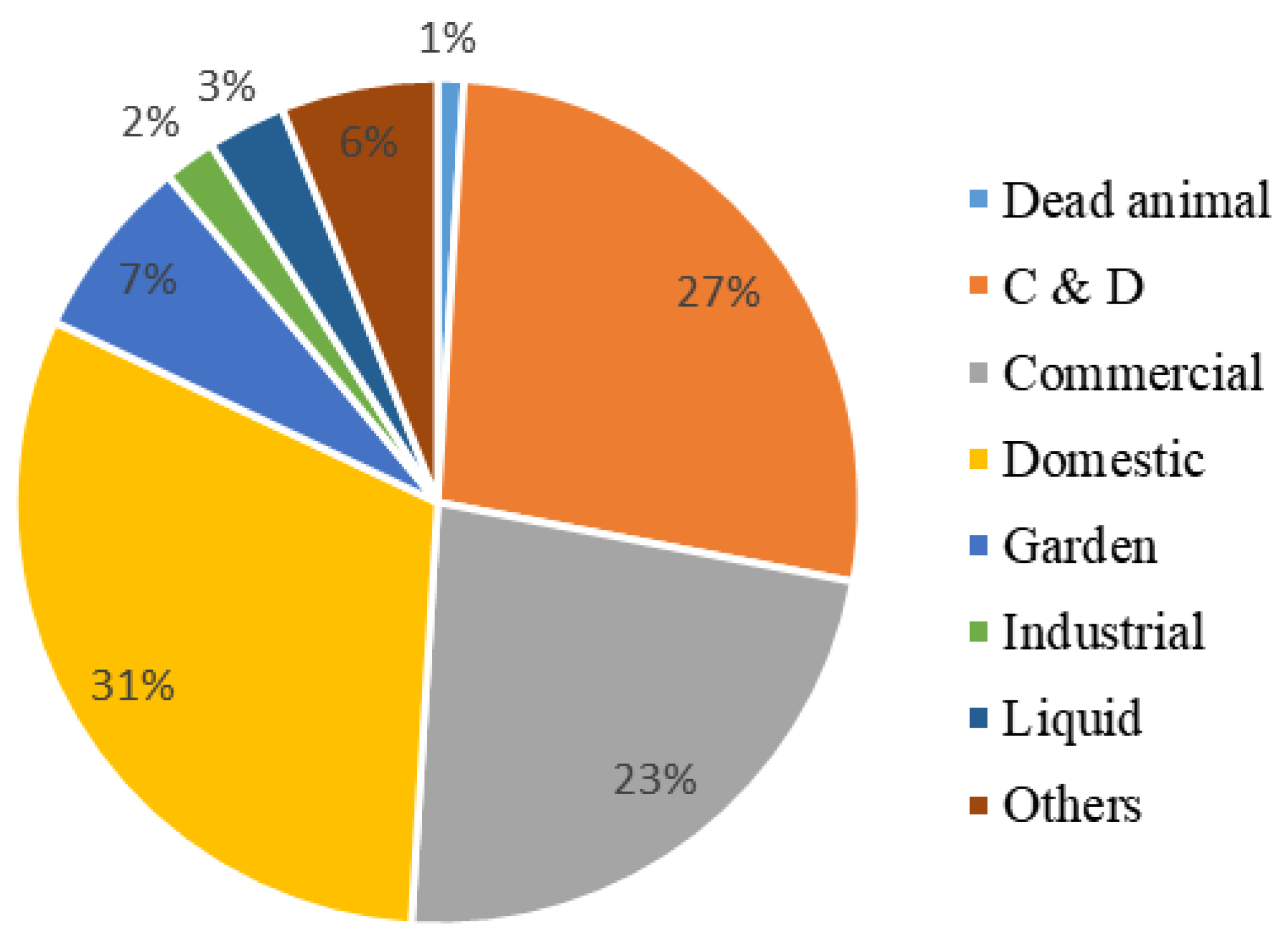
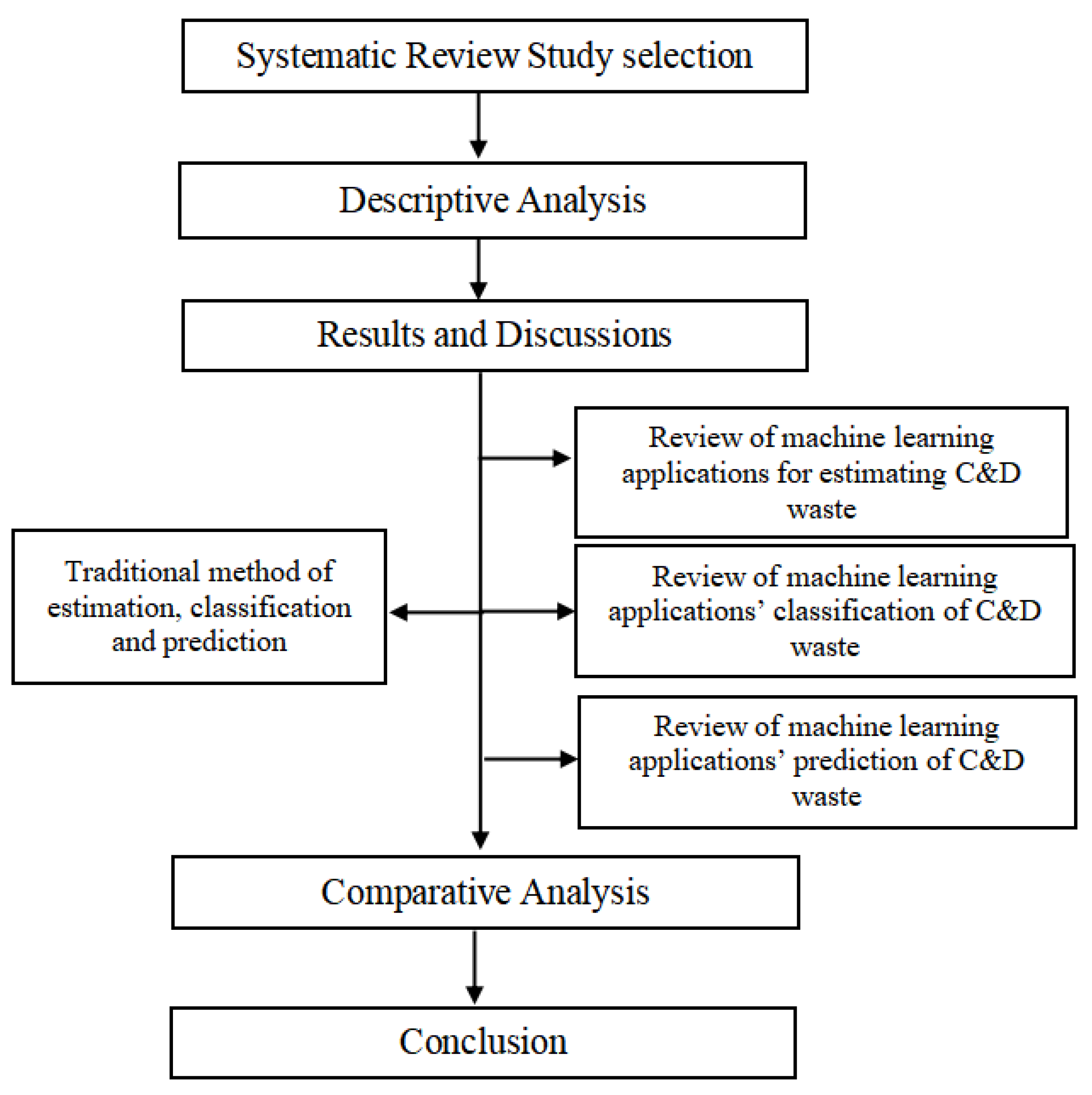

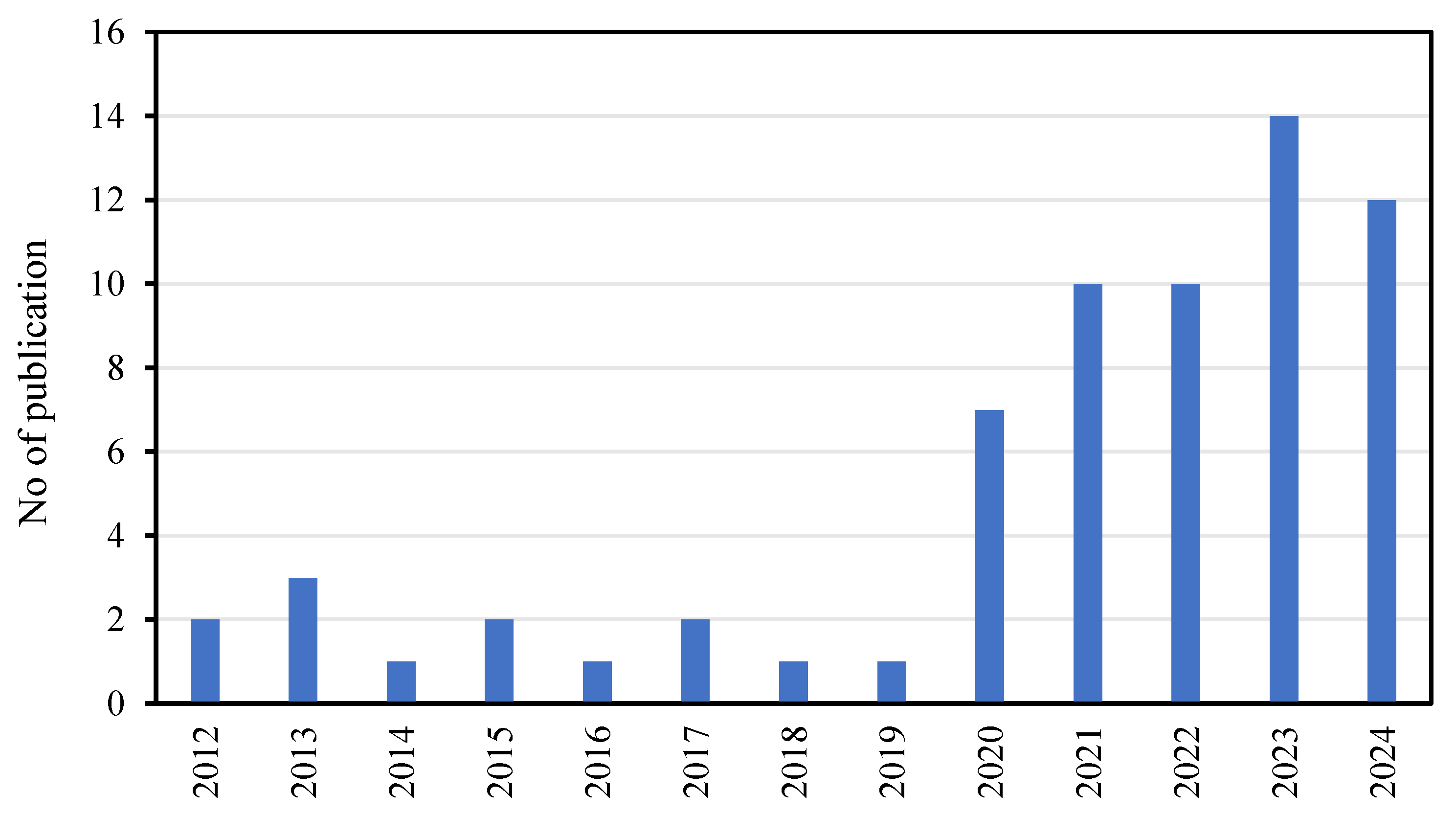

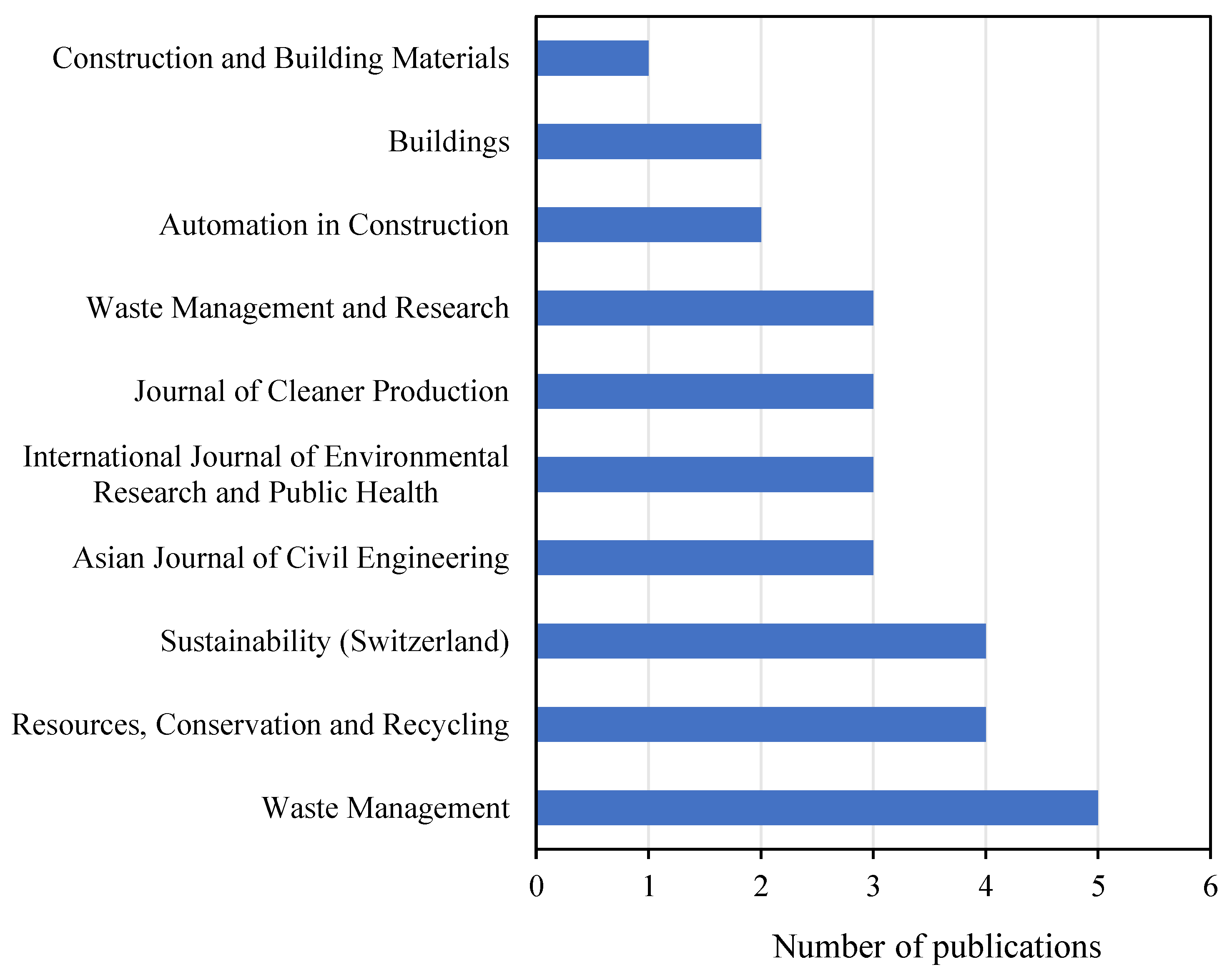
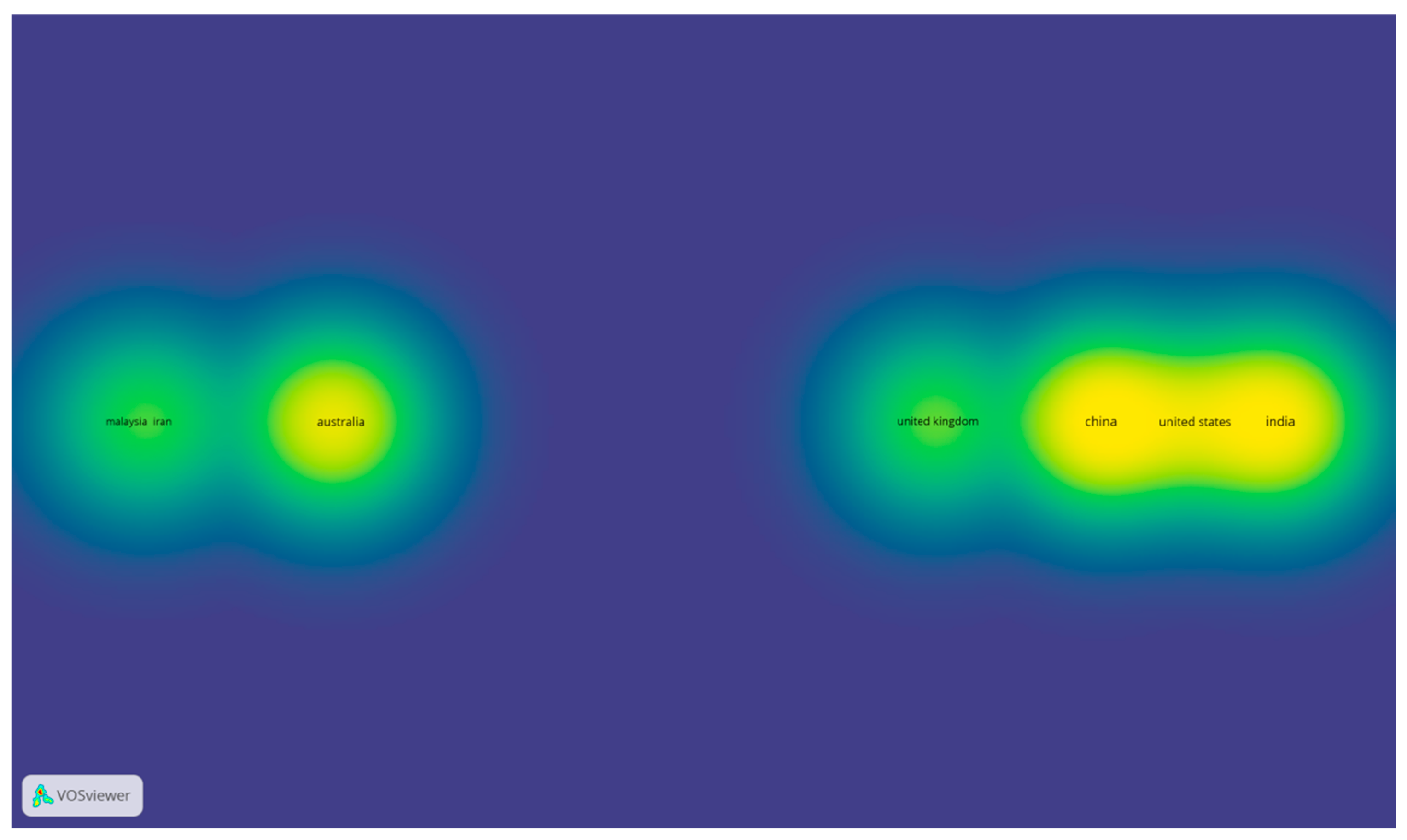
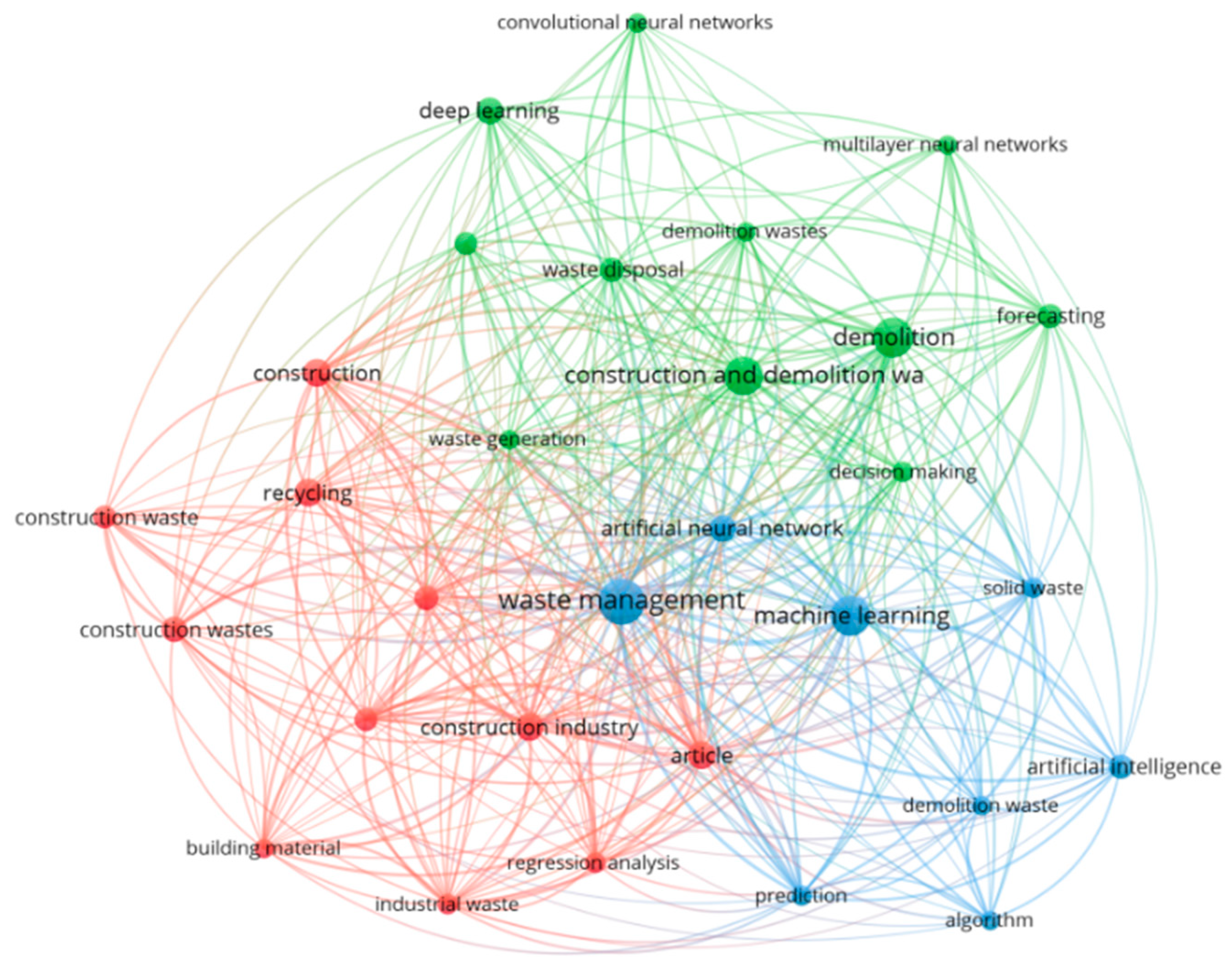
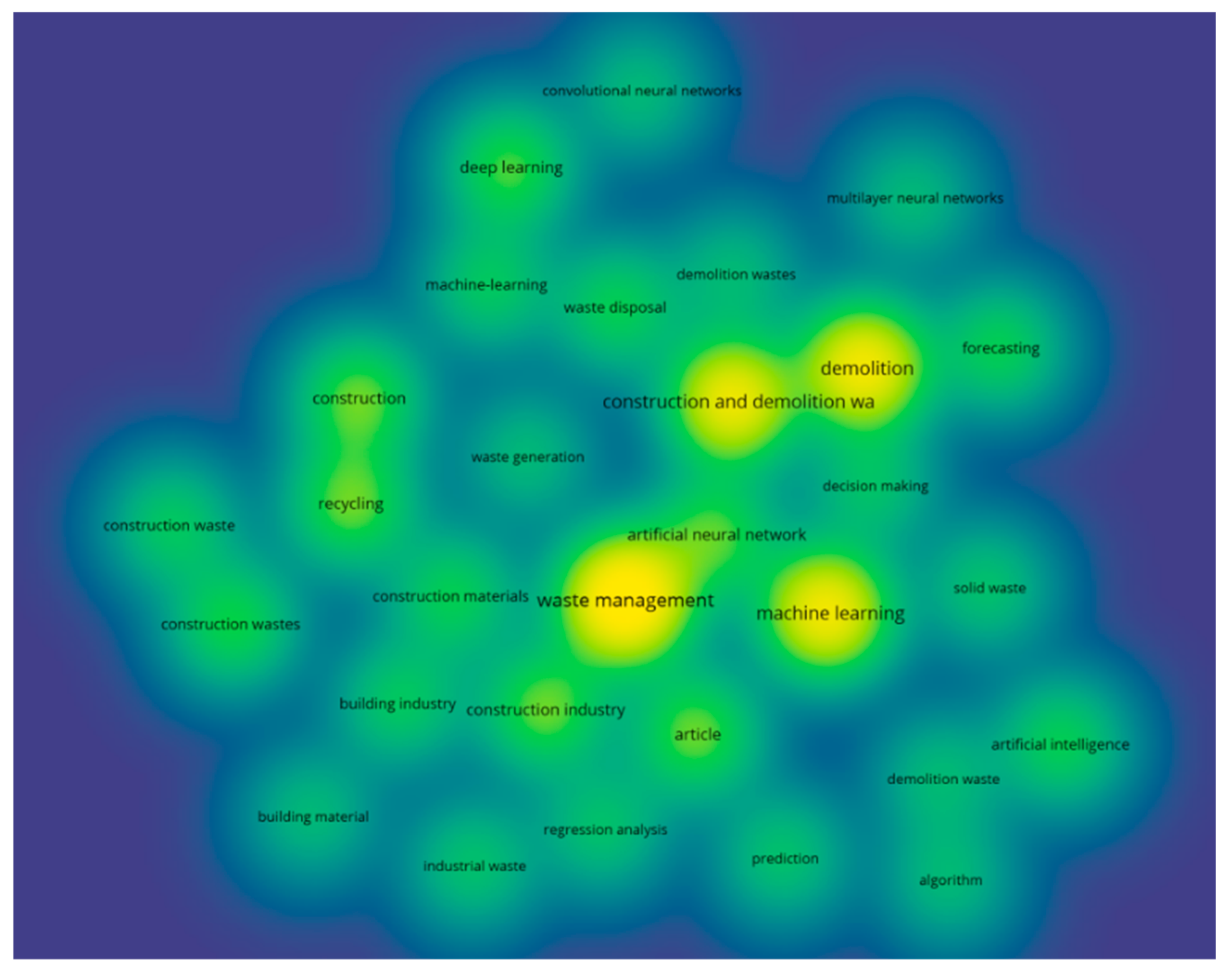

| Country | Documents | Citations | Total Link Strength |
|---|---|---|---|
| United Kingdom | 4 | 369 | 5 |
| United States | 5 | 593 | 5 |
| China | 10 | 413 | 4 |
| Australia | 5 | 403 | 3 |
| Iran | 2 | 99 | 2 |
| Hongkong | 3 | 92 | 1 |
| India | 9 | 65 | 1 |
| Malaysia | 2 | 24 | 1 |
| Brazil | 4 | 315 | 0 |
| South Korea | 8 | 94 | 0 |
| Turkey | 2 | 41 | 0 |
| Author(s) | Model(s) Used |
|---|---|
| [1] | ANN |
| [2] | Multi-layer perceptron artificial neural network (MLP-ANN) |
| [3] | Monocular vision, Deep learning model |
| [5] | Single-stage (SSD, YOLO) and two-stage (Faster-RCNN) detectors with various backbone feature extractors (ResNet, MobileNetV2, EfficientDet) |
| [15] | Hybrid AI models using CATPCA, ANN (MLP), SVMR, CATPCA–ANN (MLP), and CATPCA–SVMR |
| [16] | Deep learning framework in R programming: DNN, RNN, CNN |
| [17] | ANN (neural networks with two, five, or ten neurons in the hidden layer) |
| [20] | CAD, Linear regression models |
| [22] | Decision tree and KNN, Neural Network |
| [23] | Logistic regression, kernel SVM, KNN, RF, XGBoost, CatBoost |
| [24] | Various ML algorithms: ANN, KNN, LR, RF, and SVM |
| [25] | CNN |
| [27] | BIM, IoT |
| [31] | Decision tree and KNN |
| [32,33] | Principal Component Analysis (PCA) with decision tree, K-nearest neighbors, and linear regression algorithms |
| [34,35] | Decision tree (DT)-based ensemble models: Random Forest—RF, extremely randomized trees—ET, Gradient Boosting Machine—GBM, and extreme gradient boost—XGboost |
| [36] | AI (general term) |
| [37] | CNN-LSTM SWOT Analysis |
| [38] | LR, Pre-Renovation Auditing PRA, machine learning regression |
| [39] | Support vector machine regression (SVMR) Model, Categorical Principal Components Analysis (CATPCA) |
| [40] | Random Forest (RF) and Gradient Boosting Machine (GBM) |
| [40] | Random Forest (RF) |
| [41] | ANNs (neural networks with one and two hidden layers) |
| [42] [43] | GWO-ANN, AOA-ANN ANN |
Disclaimer/Publisher’s Note: The statements, opinions and data contained in all publications are solely those of the individual author(s) and contributor(s) and not of MDPI and/or the editor(s). MDPI and/or the editor(s) disclaim responsibility for any injury to people or property resulting from any ideas, methods, instructions or products referred to in the content. |
© 2025 by the authors. Licensee MDPI, Basel, Switzerland. This article is an open access article distributed under the terms and conditions of the Creative Commons Attribution (CC BY) license (https://creativecommons.org/licenses/by/4.0/).
Share and Cite
Samal, C.G.; Biswal, D.R.; Udgata, G.; Pradhan, S.K. Estimation, Classification, and Prediction of Construction and Demolition Waste Using Machine Learning for Sustainable Waste Management: A Critical Review. Constr. Mater. 2025, 5, 10. https://doi.org/10.3390/constrmater5010010
Samal CG, Biswal DR, Udgata G, Pradhan SK. Estimation, Classification, and Prediction of Construction and Demolition Waste Using Machine Learning for Sustainable Waste Management: A Critical Review. Construction Materials. 2025; 5(1):10. https://doi.org/10.3390/constrmater5010010
Chicago/Turabian StyleSamal, Choudhury Gyanaranjan, Dipti Ranjan Biswal, Gaurav Udgata, and Sujit Kumar Pradhan. 2025. "Estimation, Classification, and Prediction of Construction and Demolition Waste Using Machine Learning for Sustainable Waste Management: A Critical Review" Construction Materials 5, no. 1: 10. https://doi.org/10.3390/constrmater5010010
APA StyleSamal, C. G., Biswal, D. R., Udgata, G., & Pradhan, S. K. (2025). Estimation, Classification, and Prediction of Construction and Demolition Waste Using Machine Learning for Sustainable Waste Management: A Critical Review. Construction Materials, 5(1), 10. https://doi.org/10.3390/constrmater5010010






